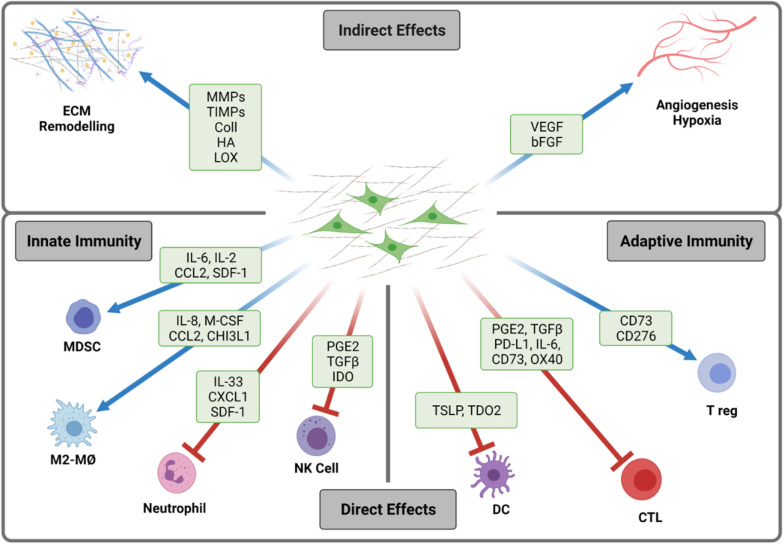Fig. 1.
CAF-mediated immunoregulatory functions in the tumor microenvironment. Cancer-associated fibroblasts (CAFs) participate actively in the reciprocal communication with tumor and immune cells in the tumor microenvironment (TME) and are recognized contributors to immune escape by affecting recruitment and function of different innate and adaptive immune cells. Effects from CAFs on immune cells can be exerted directly via release of potent immune regulators and exosomes and/or expression of regulatory receptors on the cell surface, as well as indirectly by regulation of extracellular matrix (ECM), tissue stiffness, angiogenesis and hypoxia. Red arrows represent negative regulation, and blue arrows represent positive regulation. bFGF basic fibroblast growth factor; CD73 cluster-of-differentiation-73; CCL2 chemokine (C–C motif) ligand 2; CHI3L1 chitinase-3 like protein 1; coll collagen; CTL cytotoxic T lymphocyte; CXCL1 chemokine (C–X–C motif) ligand 1; DC dendritic cell; ECM extracellular matrix; GM-CSF granulocyte–macrophage colony-stimulating factor; HA hyaluronan; IDO Indoleamine-2,3-dioxygenase; IL interleukin; LOX lysyl oxidase; MDSCs myeloid-derived suppressor cells; MMP matrix metalloproteinases; MØ macrophages; NK cell natural killer cell; PD-L1 programmed death ligand-1; PGE2 prostaglandin E2; SDF-1 stromal-derived factor-1; TDO2 tryptophan 2,3-dioxygenase; TGFβ transforming growth factor beta; T reg regulatory T cells; TSLP thymic stromal lymphopoietin; VEGF vascular endothelial growth factor. Schematic created by BioRender

